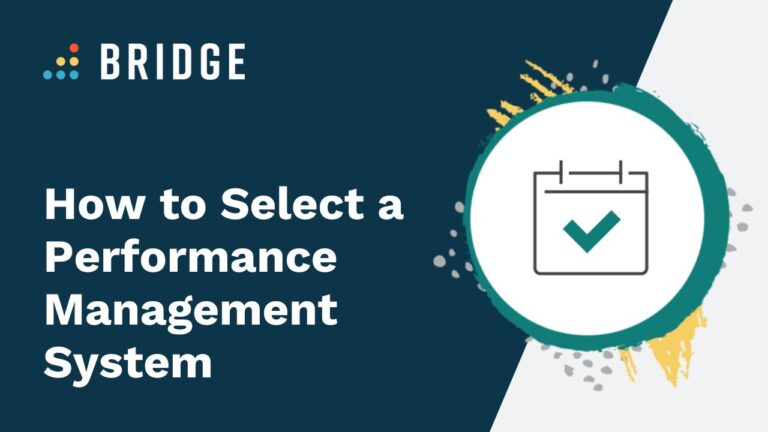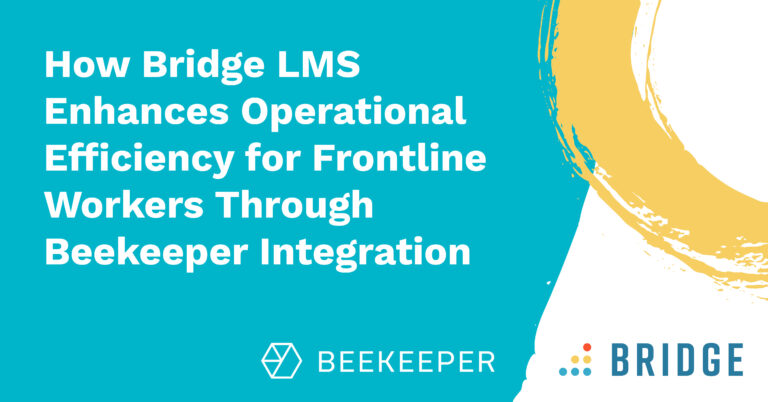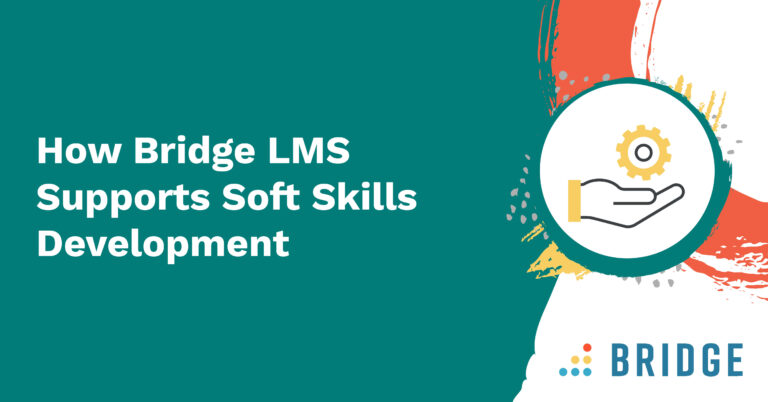Performance management systems can be exceptionally powerful tools, packed with features capable of elevating employee performance to exciting new heights—but they’re still just tools.
So, to some extent, the best performance management system for your organization will be one that’s compatible with your existing performance philosophy. After all, a tool is only as good as the people who use it!
In that sense, performance management systems are a little like gym memberships: no matter how much you pay, and no matter how impressive the facilities are, you’ll only feel the benefits if you’re ready and willing to use them. And to stretch (pun intended!) the analogy a little further, you’re more likely to use your gym membership if you choose the exercises that work for you. A natural rock climber, for example, will be less likely to take advantage of unlimited access to the swimming pool.
At the same time, you don’t have to limit yourself to performance management systems that mirror and enhance your existing process. It’s equally important to ask yourself what you want your performance process to look like, and focus on systems that help you to implement the habits and practices that will take your approach to the next level.
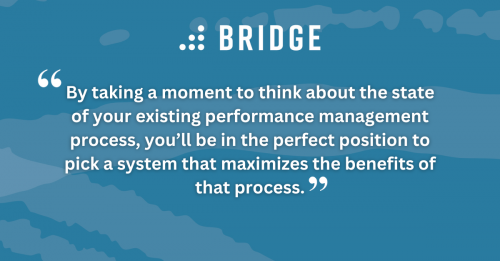
How Do You Manage Performance Today?
By taking a moment to think about the state of your existing performance management process, you’ll be in the perfect position to pick a system that maximizes the benefits of that process. Here are a few questions to ask yourself.
Are Your 1:1 Check-Ins Hitting Every Talking Point?
Let’s assume that your organization has already embraced a continuous style of feedback in which your managers meet their reports for in-depth 1:1 meetings on a weekly basis. Once you’ve identified continuous feedback as a key component of your performance management style, you’ll be able to seek out performance management systems that enhance your frequent 1:1s.
If your 1:1 meetings are currently unstructured, or if you lack a way to keep track of important topics to discuss, you’ll benefit from a performance management system that supports more sophisticated agenda-setting features. Some systems will allow you to link your 1:1 agendas to items like current tasks, new achievements, ongoing goals, and recent eLearning enrollments.
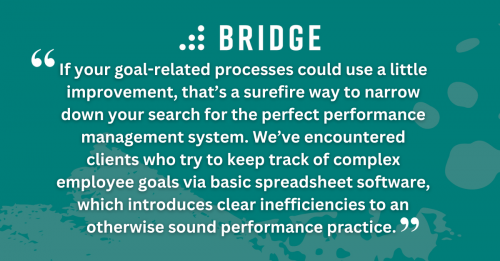
Do You Track Employee Goals Efficiently?
As you take stock of your performance philosophy, you might find that you’re up to date with current thinking on the importance of goals. You might, for example, have policies in place to ensure that the goals your people set adhere to the SMARTER acronym, meaning that they’re:
- Specific
- Measurable
- Achievable
- Relevant
- Time-bound
- Evaluated
- Revised
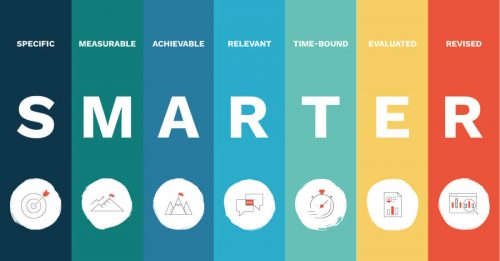
If, however, you find that your goal-related processes could use a little improvement, that’s a surefire way to narrow down your search for the perfect performance management system. We’ve encountered clients who try to keep track of complex employee goals via basic spreadsheet software, which introduces clear inefficiencies to an otherwise sound performance practice.
Recognizing this kind of weak spot in your existing process might lead you to a performance management system capable of tracking goals in a more centralized and comprehensive way. Not only will the right system allow managers and employees to keep on top of their goals, but some systems will improve goal measurability by offering different progress metrics, such as the number of completed subtasks or a simple percentage.
FIND OUT MORE ABOUT SMARTER GOALS | ‘What Are SMARTER Goals and How Do They Help Measure Employee Productivity?’
Choose Performance Software That Supports Your Aspirations
While it’s important to factor your current performance approach into your decision, selecting a performance management system should equally be about finding a platform that allows you to grow and improve your processes.
Organizational change isn’t always easy, largely because your new system will need to be taken up by employees who might be unsure of new technologies or practices. In the words of Dr. David A. Shore, a Harvard-based authority on organizational change: “if you can’t change your people, you can’t change anything”.
As such, any performance management system you select should be able to provide top-dollar features and—crucially—encourage your people to form new habits built around those features.
Once again, this process involves a little self-reflection. Ask yourself:
- What is our performance management process lacking?
- What are the most important changes we need to make?
- Is there enough employee motivation and leadership support to kick off new performance management habits?
Whittling down your employee performance preferences with questions like these will allow you to select a platform that supplies the features you need and offers ways to cement the positive changes that you’re ready to bring about. To help with this decision, you’ll also need to know how a performance management system can help you make your changes stick.
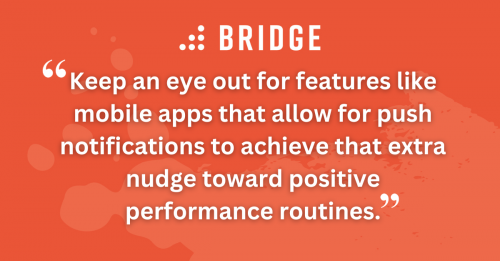
Make Changes That Last With Habit-Forming Features
Although a system alone can’t develop habits for you, there’s a range of performance platform features that can be instrumental in supporting the habits you’re looking to form.
Let’s assume—in contrast to the previous example—that you’re looking to improve the frequency of your 1:1 employee-manager interactions. You’re aware that employees credit continuous feedback with the motivation to produce outstanding work, your leadership team and managerial staff are committed to making it happen, and you’re looking for a performance management system to help you out.
In that scenario, you’ll benefit from a performance management system that supplements your 1:1 meeting aspirations by both scheduling those meetings formally, sending reminders prior to meetings, and keeping managers informed if any meetings are overdue. Keep an eye out for features like mobile apps that allow for push notifications to achieve that extra nudge toward positive performance routines.
Similarly, if you’re looking to bolster your employee development by providing employees with a more structured means of upskilling and learning, you might want to select a system that offers features like career driver exercises or formal development plans. These aspects of your prospective performance management system will encourage your people to stay the course and commit to their long-term growth objectives.
LEARN HOW TO DEVELOP YOUR PEOPLE | ‘4 Steps to Create an Employee Development Plan’
Upgrade Your Knowledge of Performance Management Systems
Bridge Performance Management
Bridge gives organizations the power to engage and develop their people through its performance management platform. In one unified experience, align goals, identify top performers, fill skill gaps, build a culture of continuous feedback, and make informed talent decisions. The platform offers performance reviews, 1on1 agendas, development plans, skills feedback and talent reviews. Bridge has helped organizations build consistency and alignment when it comes to employee development and growth.
This blog post is an extract from our ebook, ‘Does My Organization Need a Performance Management System?’. Download the full ebook to discover how to implement the system you’ve spent so much time selecting. Alternatively, if you’re ready to see how Bridge’s performance management system can help your organization, we’d love to show you.
